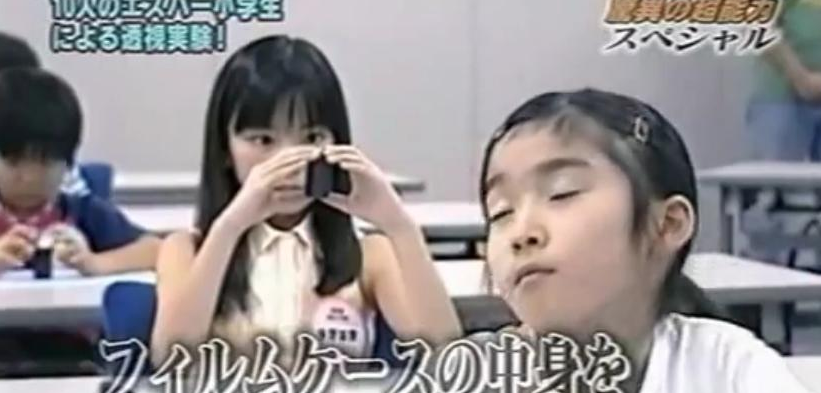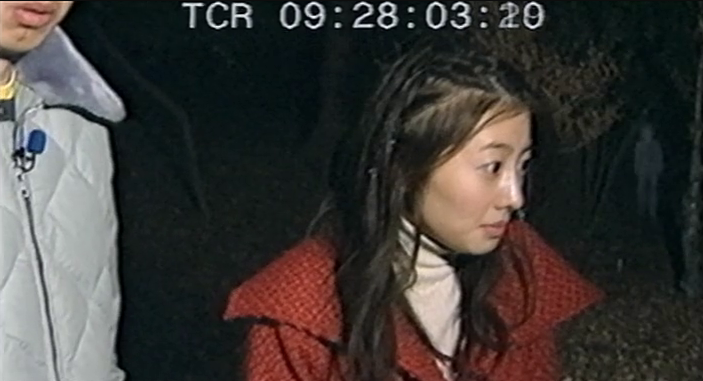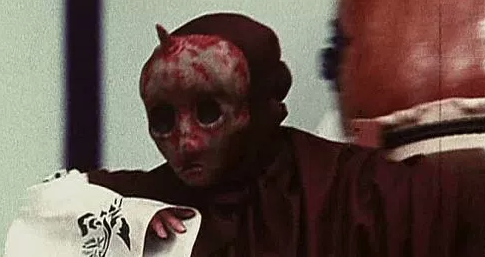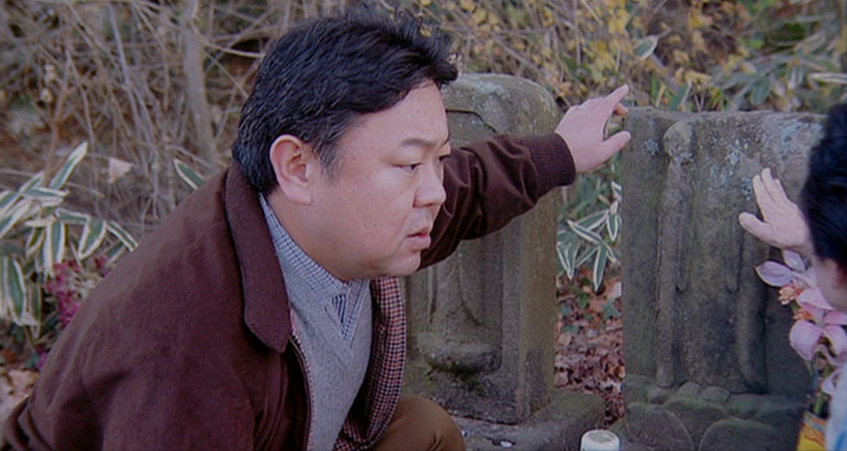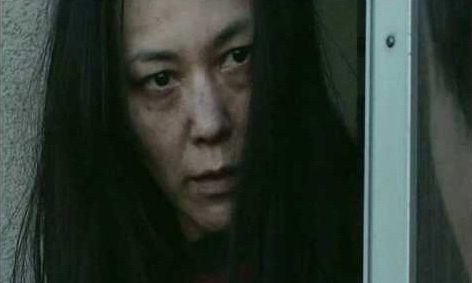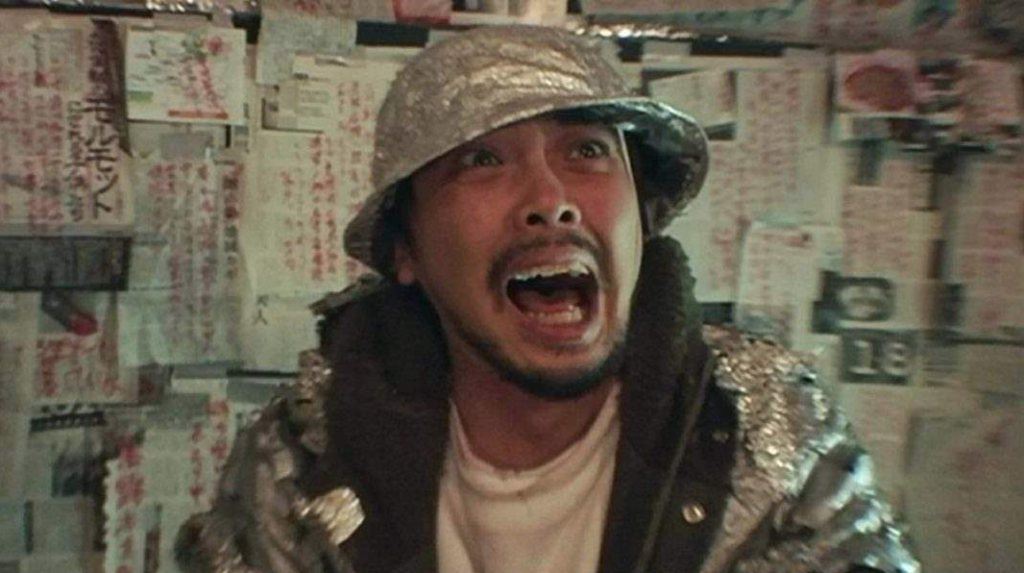
This January, in support of the Toronto Rape Crisis Centre / Multicultural Women Against Rape, friends and family have raised over $1,500 (which, when matched by my employer, totals $3,000). As a result, I now have to watch and write about thirty-one horror movies: one each night. Any donors who contributed over $30 were given the option to choose one of the horror movies I must subject myself to. After each viewing, I will write some things about said movies on this website. Be forewarned that all such write-ups will contain spoilers, and many of them will refer to unpleasant and potentially triggering situations. Today’s film is a recommendation by friend and author Pasha Malla, the excellently titled Hell House LLC, a found-footage film from 2015 directed by Stephen Cognetti. I watched it on the Shudder streaming service.
What happens:
Trigger warnings: Suicide, sexual harassment.
The premise of Hell House LLC is a fictional documentary about a 2009 tragedy at a haunted house attraction in Abbadon, New York, in which 15 people died under mysterious circumstances. As talking head Robert Lyons (Theodore Bouloukos) explains, “Hell House was a real tragedy on many levels.” (Mainly just the one level, though: all the deaths.) The documentary, produced by Diane Graves (Alice Bahlke) informs us that on October 8, 2009, an old hotel that had been refurbished for Halloween amusement purposes became the site of tragedy, then they run a YouTube video that emerged following the attraction’s closure, shot by one of the surviving tour-goers.
A young couple tapes their experience in the haunted house, and it starts out with the usual shocks: spooky skulls and strobe lights. Then a man in a clown costume races by in a panic, and he’s later followed by a woman wearing civilian clothes. This doesn’t seem like something that’s supposed to happen. Once they reach the final stop on the haunted house tour – the basement – they encounter a logjam. People are screaming more than usual – actual terror! – and the crowd, packed in the basement like sardines, struggles to free themselves. Everyone rushes out as fast as possible; we see tables and carts topple in the rush to escape.
This only publicly available video of the night’s events is paired with a 911 call that was recorded from within the haunted house: a woman gasping about something on the wall. The official cause of the 15 victims’ deaths is “severe malfunction” (whatever that means). But the documentary crew then speaks to journalist Martin Cliver (Jeb Kreager), who controversially snuck into the hotel after the incident and snapped some photographs. The photos revealed dried blood on the floor, which doesn’t jive with the generally accepted theory of a gas leak. But even Cliver doesn’t venture into the basement; too scared, he takes his photos from the top of the stairs.
Enter Sara Havel (Ryan Jennifer Jones), who was part of the Hell House company that sets up haunted house attractions in the New York area every Halloween. She meets with Diane Graves for an interview and warns that if people knew what really happened in the old hotel, they wouldn’t accept it. She then gifts Diane and the crew a bagful of VHS tapes, a record of everything they saw and witnessed while setting up the house. When Diane asks why these tapes weren’t submitted to the police, Sara ominously says, “You’ll see.”

The remainder of the film is mostly comprised of these Handicam recordings made by Paul O’Keefe (Gore Abrams), a moustached member of the Hell House company whose interests seem limited to women and different ways to sexually harass them. The tapes begin in the drive to Abaddon, which we’re told is about a 40-minute drive from New York City. The white frat-like crew consists of the aforementioned Paul and Sara, but also Sarah’s boyfriend and founder of the company, Alex Taylor (Danny Bellini); his lifelong friend Andrew “Mac” McNamara (Adam Schneider); and Paul’s buddy, Tony Prescott (Jared Hacker). They soon arrive at the vacant Abaddon Hotel and realize most of their set dressing has been done for them already: the hotel is creepy as hell!
Our heroes scope out the inside of the long-condemned hotel: it’s in disarray. The roof leaks, the electricity (obviously) is out, and tables in the dining room have been overturned. “It smells like a sweater,” Sara notes. They find a shattered plate with an illustration that bears a passing resemblance to Sara. One other thing: though the company doesn’t notice at the time, we viewers see a black hooded figure in the background. The creepiest part of the old hotel is the basement, which already has disturbing wall art. Alex’s plan is to chain a paid actor to the wall as some sort of fake virgin sacrifice, and feature a number of clown mannequins (including one actor) along the far wall. They notice a ton of discarded old books on the floor – all of which happen to be Bibles. “It’s a hotel,” Alex reasons. “There are Bibles in every room.”
Paul and Tony get the electricity up and running within two weeks, and the members of the crew begin to live in the hotel. That’s when, Sara suggests, “things began to change.” Tony sets up security cameras throughout the house, but he can’t get them to function in the basement. This is a serious security issue – especially if they have an actress in a state of undress chained to a wall down there. Between creepy comments, the boys decide they’ll hire a really beefy actor to portray one of the clowns in the basement, and he can double as security.
Paul records himself, confession-cam-style, late at night, complaining, in the most unpleasant way possible, about how #thirsty he is. Spookily, we see a figure moving around in the dark behind him, but when Paul calls out and asks if it’s Sara or one of his other friends sleepwalking, there’s no answer. Paul next peeps on Alex and Sara in their underpants before announcing the hired actors have arrived. The camera zooms in on one actor in particular, Melissa (Lauren A. Kennedy), who will portray the “damsel in distress” chained to the wall. (Need I remind you that Paul is a sex pervert with no boundaries.) However, the documentary breaks to interview the journalist, Cliver. He spoke to one police officer who said the first body he found was a member of the Hell House crew with a self-inflicted throat wound. Additionally, Joey Steffler (Phil Hess), the beefy actor stationed in the basement, made it out of the house alive, but refused to talk to police and killed himself nine days later.

Alex goes over the role with Melissa, and Melissa informs him of rumours about the hotel. That the original owner hanged himself and guests kept going missing. Paul, behind the camera, does about eight things that could get him fired for sexual harassment, but we then move on to our talking heads, who tell us the history of the hotel. Andrew Tully allegedly built the hotel in Abaddon because the name of the town reminded him of a demon who guards the gateway to hell. But some time after opening, a mother and daughter vanished, having last been seen at the hotel. Though nothing could be tied conclusively to the hotel, business suffered and Tully hanged himself in the dining room. (We even see a file photo.)
Back in 2009, our team sets up the creepy clown mannequins in the basement but are frustrated that the mannequin heads are immobile. They begin to hear strange noises at night and hang out a bit with Joey, their clown actor who they “discovered” at a local gas station. He can pop out his eye on command. (Gross!) While Paul and Mac are in the hotel alone, Tony goes missing. Paul searches him out. He finds Tony, in the clown garb, staring into the basement. The clown slowly turns to him. When Paul goes to tell Mac he found Tony acting strangely, there Tony is (looking conspicuously not like a clown). Paul loses it, flipping out that someone else in a clown suit must have broken into the house. He shows the others the video evidence, but they think he’s played some sort of camera trick on him.
The gang films a commercial for their haunted house in the hotel’s yard and Sara drifts away to stare eerily at a statue of the Virgin Mary. Stranger things continue to happen: during a dry run of the haunted house tour, Paul sees “creeps” through the strobe lights that don’t match the models they placed there. There are supernatural forces at work in the house. Paul begins to actively freak out, but Alex pressures him to calm down. The attraction is two weeks away from opening night, and he doesn’t want Paul to scare the actors.

That night, Paul is awakened by a terrible noise. When he leaves his room, he sees the super-scary clown on the stairs. Paul summons Mac, who – braver than Paul (or I) – approaches the clown and confirms it’s just a mannequin. Someone was messing with them. But Sara, however, is standing in the other room, Blair-Witch-style against the wall and speaking in backwards tongues. Paul and Mac rouse her from her trance and she begins to panic. When they turn back to the stairs, the clown mannequin has vanished! Then the clock strikes in the dining room. When they take a look, a candelabra has been lit at the dining table. Everyone panics and runs upstairs, past the clown mannequin (now holding a lantern).
Paul returns to the confession cam with three days to go. He notes that Sara is not looking good, though “she usually does.” When he wakes up that night, there’s a woman slumped against his bedroom wall. She stirs and slowly moves toward Paul, who hides himself under his blanket like a three-year-old. When he peeks out from behind the covers, she’s suddenly very close. Paul screams.
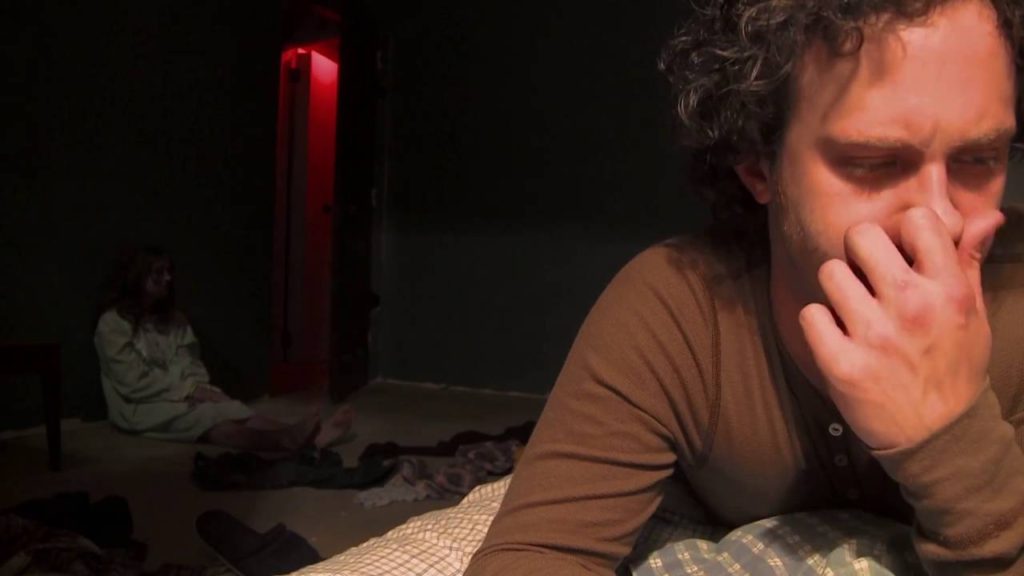
Tony is the next person to turn on the camera. He and the others are looking for Paul, as he’s gone missing just days before opening. Mac, however, is unconcerned: Paul has flaked out on them in previous years and can’t be relied upon. Tony asks Alex to try calling Paul’s cell phone and all they hear is a squeal of angry white noise. In the evening, they are awakened by the sound of the piano downstairs. Assuming Paul has returned, they descend the stairs, but can find no sign of him. The sounds however, seem to have moved to the basement, so they continue downward. The basement, naturally, is pitch black, lit only by their flashlights. When Tony trains his light on the clown mannequins, he sees all their heads have turned. But their heads were supposed to be immobile! He screams and pushes Mac and himself into a locked room to hide. When they extract themselves, the clowns are back in their normal positions, but Paul has appeared. He’s lying slumped against the basement wall. And while they determine he’s alive, he’s not nearly as jovial as he usually is. (The first warning sign is he’s stopped being a total lech.)
By this point, Tony is convinced that they need to scuttle the whole haunted house idea. Too many scary and inexplicable things have been happening; Paul is back but is not himself. When Alex refuses to shut things down, Tony threatens to quit and storms out of the hotel. Mac chases him down and says he needs to tell him something. The tape omits what that “something” is, but it convinces Tony to stay on. Some secret that only Mac and Alex know has tethered him to the project. Tony is resigned to the fact that this haunted house has to happen; he can’t leave now.
The documentary producer, Diana, asks Sara if Alex was of “sound mind” going into opening night. Sara says he was, but the tape shows him on opening night wearing a T-shirt and vest, so just how sane was he? In fact, he’s not his usual confident self when giving a pre-game pep talk to the costumed actors and is visibly shaken. Mac, who has taken over camera duties, goes to check on Paul, and he’s lying unresponsive in bed. But in good news, they have a large opening-night crowd, eager to get into Hell House. The team adds the final touches to the house, which concludes with Mac tearing open the shackled Melissa’s dress in the basement. (Why they didn’t just have costuming for this already is anyone’s guess.)
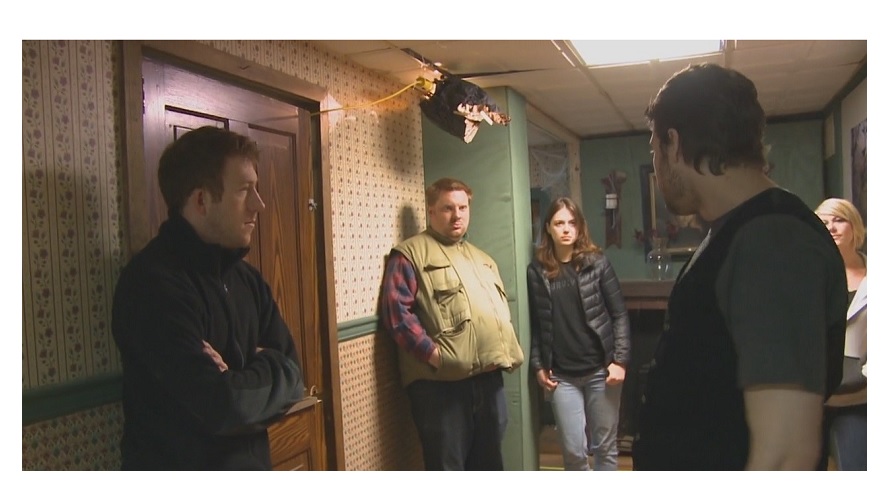
The team’s walkie-talkies begin to malfunction, so Tony and Alex, in the control room, have no way of speaking to everyone else. Sara runs into Mac, who’s hidden behind a lattice to oversee the night’s festivities. She notifies him that Joey, in his clown suit, just blew past her on his way out of the hotel. They hear intense screaming from the basement – nothing they planned was quite that scary – so Mac asks her to find Alex. Meanwhile in the basement, something is very much amiss. A few black hooded figures that look essentially like Dementors from Harry Potter, have arrived to menace the crowd and the chained-up Melissa. The audience intuitively senses this is not part of the show and pandemonium erupts.
Mac guides as many guests as possible out of the house, but finds himself locked in immediately after. He and Sara run around the house in a panic, finally making their way up the stairs to the attic, where Alex has hanged himself. Mac tries to pull his friend down, but the imposing Dementors arrive and swarm him. The camera falls to the ground.
Diana asks Sara what happened after that, and she says she left the attic and went downstairs. The police arrived soon after. The interviewer is dubious she could just waltz out, but Sara asks to be excused. Sara leaves, encouraging them to look in the Abaddon Hotel themselves. She will be in Room 2C at her own hotel if they need to reach her again. The camera crew makes a hasty decision to break into the site of the crimes at 5 in the morning. Before they go, they try to leave a message at Sara’s hotel, but find there’s no ‘2C’ nor ‘Sara Havel’ at the hotel.
Crew member Mitchell is left behind to catalogue further footage that Diana really should have watched before leaving. In the new footage, we see Sara leaves the attic and finds Paul on the ground floor. Paul, looking intense and distraught, begins to punch Sara a few times, and we next see her on the ground, beaten and bloodied. She is then dragged out of view and the camera records Paul from the knees down. He picks up a shard of broken glass and cuts his throat, which we realize has happened once his dead body drops into the picture frame.
But it’s a bit too late: Diane and her cameraman have entered the hotel and spotted the path of dried blood that marks where Sara was dragged. Diane is gleeful to spot a bloody handprint in the basement, but the cameraman isn’t so excited. He refuses to enter the basement. Mitchell tries to call Diane on her cell phone to warn her of what he saw, but she won’t answer. They head upstairs and see one of the bedrooms marked ‘2C.’ (It’s honestly the most chilling thing.) Though the cameraman doesn’t want to, Diane insists they enter. They see Sarah, seated on a mattress on the floor. Diane asks if Sarah is okay. She slowly turns, revealing a face that is partially rotted away. Diane and her camera guy begin to yell, and the mysterious hooded figures in black approach.

Takeaway points:
- Though it did not concern this film, my sometime horror film companion David Demchuk asked an astute question: “When do characters realize they are in a horror film?” So often, the answer is never. The characters in Hell House LLC never do, which I suppose is why they persist in sleeping in the haunted hotel (despite having videotape evidence of something demonic), why they seem unfazed by the fact that Paul has become an entirely different person after mysteriously disappearing. Likewise, the reporters who are making a documentary literally about how the hotel is the site of many recent, inexplicable deaths – who zoom in on mysterious figures in raw footage – decide it’s a good idea to enter the house again, to check out the basement. It’s like they haven’t been involved in the very movie they are purportedly making. Obviously, characters in horror movies are going to do dumb things sometimes, but disbelief can only be suspended so far.
- Hell House LLC answers the question that no one really asked: what if a bunch of bros bought a haunted hotel? The entire Hell House team are unpleasant to spend time with, as they relentlessly creep on women, joke about topless actors, and act like extras in an early Blink-182 video. Even in the depths of his utmost terror, Paul (ringleader of the sexual harassment circus) still manages to skeeve out on Sara. My wife remarked, partway through, “I hate every one of these people.” (We were in a bit of a hurry to watch them die.) It’s unclear if the characterization is meant to depict the real dynamics of a bunch of privileged white guys who grew up together and decided they wanted to spend a lifetime scaring folks, or just the side effect of making film that has similar human resource issues.
- Once again, we see the forces of unfettered capitalism are to blame for supernatural doom. From Poltergeist to Aliens, the profit impulse is what causes so many people in horror movies to die grisly deaths. Though we’re not informed of the reason Tony decides to stay in the company when thoroughly spooked, from numerous hints, we can assume Hell House LLC is close to financial ruin. So in this case, it’s not even individual greed that drives them to death – rather an effort to not see friends bankrupted. In late-stage capitalism, even personal friendships will be abused by the company. Horror seems primed to turn the current wave of tech “disruptors” into new horror premises, though my wise wife informs me that’s essentially the idea behind Black Mirror.
- Though the town of Abaddon is completely fictional, the hotel seems loosely based on the very haunted Shanley Hotel, in Ulster County, New York. Built in 1895, the hotel was the site of many accidental deaths and said to be one of the most haunted spots in the tri-state area. Among the phenomena on tap at the Shanley: chiming of clocks, footsteps, objects moving, ghost cats, piano music and more. (You can currently stay in the Shanley Hotel, if your nerves can handle it and you’re over 16 years of age.)
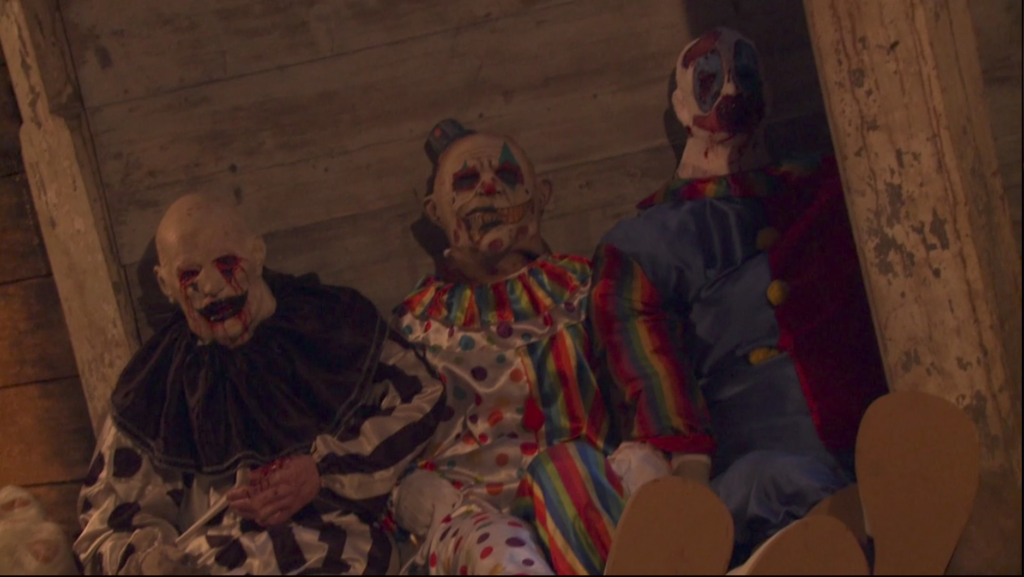
Truly terrifying or truly terrible?: If you watch Hell House LLC, I have no doubt you’ll be scared. There are chilling moments. For me, the initial encounter with a clown was terribly unsettling. And merely the discovery of a Room ‘2C’ in the hotel gives me chills just thinking about it. There are scares to be had, but it’s a bit of a one-trick pony. It’s like a haunted house itself. Scares you in the moment, but there’s nothing particularly thoughtful behind those scares.
Best outfit: As with most found footage movies, fashion is not its strong point. The commitment to realism means the characters are not stylish, because most real people aren’t stylish. This is especially so in Hell House LLC, where it’s a lot of basketball shorts and Teva sandals. I liked Sara’s Pac-Man shirt, though.
Best line: “Tully considered himself a modern-day Dante.” – interview subject Robert Lyons, clearly confused about the Satanic powers of Italy’s epic poet.
Best kill: Most of the film, I wanted Paul dead, so I guess Paul slashing his own throat with a piece of broken glass was pretty satisfying.
Unexpected cameo: Unless you’re a die-hard indie film aficionado, you likely won’t recognize any of our actors from another place. (Such is the terrible fate of found-footage actors, cherished for their non-celebrity.) But Jeb Kreager who plays the reporter talking head, has been getting a fair amount of work, including a role as Gunner Henderson the new Punisher Netflix series.
Unexpected lesson learned: Never date the CEO of a company specializing in haunted house experiences.
Most suitable band name derived from the movie: Abaddon Hotel.
Next up: The Devil Rides Out (1968).

